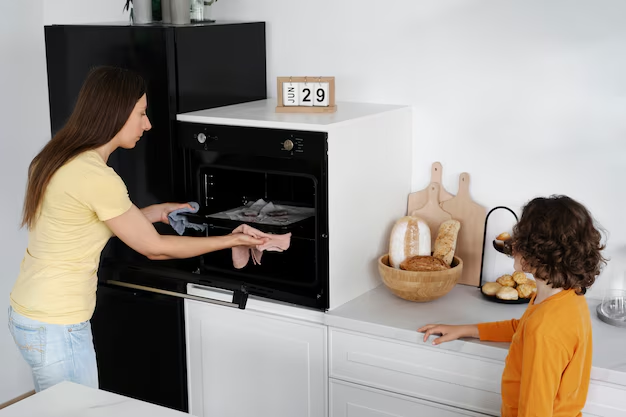Maximize Your Fridge's Efficiency: Making Your Refrigerator Colder
"Why is my refrigerator not cold enough?" It's a question many of us have asked, especially when we find that our groceries are not staying fresh as long as they should. Whether you're dealing with a refrigerator full of wilting vegetables or suspiciously warm drinks, there are several steps you can take to ensure your appliance operates at peak performance. While achieving the perfect temperature settings in your refrigerator might appear daunting, a few strategic adjustments can often resolve the issue efficiently.
Understanding Your Refrigerator's Temperature Settings
When addressing the problem of an underperforming refrigerator, the first step is to familiarize yourself with the appliance's internal thermostat settings. Most modern refrigerators operate best at temperatures between 37°F (3°C) and 40°F (4°C). Maintaining this range ensures that food is kept fresh without freezing.
- Check the Controls: Refrigerator controls might sometimes be accidentally nudged or misadjusted while cleaning or restocking. It's quick and easy to check the dial or digital display to ensure it's set correctly.
- Digital vs. Analog: With analog dials, numbers often range from low (1) to high (10), where higher numbers indicate a colder setting. For digital displays, numbers usually represent the desired temperature in either Fahrenheit or Celsius.
The Ideal Temperature Zones
Understanding the distinct zones within your refrigerator can help you make the most of whatever space you have. Not all areas of your fridge maintain the same temperature, so knowing where certain foods should be stored can improve efficiency:
- Top Shelves: Store drinks and ready-to-eat foods.
- Middle Shelves: Ideal for dairy products.
- Lower Shelves: Best suited for raw ingredients like meats due to the colder environment.
- Door: The warmest part, suitable for condiments.
Why Your Refrigerator May Not Be Cold Enough
A variety of factors can cause a refrigerator to underperform:
- Overloading: Packing your fridge to the brim restricts air circulation, leading to uneven cooling.
- Door Seals: Worn or dirty door seals can allow cold air to escape, affecting the internal temperature. A simple touch test can reveal if cold air is seeping through.
- Location and Ambient Temperature: Placing your refrigerator near a heat source like an oven can force it to work harder.
Quick Checks and Solutions
Before you decide to call a repair technician, there are simple steps you can take to diagnose and potentially solve the problem yourself:
- Clear the Vents: Ensure that vent openings inside the fridge are not blocked by food items. These vents are crucial for air circulation.
- Clean the Coils: Dust and dirt on condenser coils force the fridge to work harder. Cleaning them can often resolve performance issues.
- Inspect the Thermostat: Ensure that the fridge thermostat's setting matches your coldness requirement.
When a Deep Dive is Necessary
If quick fixes don't suffice, you might need to delve deeper to enhance your fridge’s cooling abilities:
Inspect the Gaskets
The door gasket, a rubber seal, ensures the refrigerator door closes tightly. If it’s damaged or dirty, it might not create a proper seal:
- Visual Inspection: Check for cracks or wear and tear.
- The Slip Test: Place a sheet of paper between the door and the refrigerator – if it slips out easily with the door closed, the gasket may need replacement.
Proper Ventilation
Refrigerators need sufficient space for cooling mechanisms to operate efficiently. Ensure there is enough distance (at least a few inches) between the back of the fridge and the wall.
Positioning Matters
- Level the Fridge: A refrigerator that's not level can cause doors to not close properly. Adjust the front feet to ensure a proper fit.
- Away from Heat: Relocate if it's near heat-generating appliances or direct sunlight.
Upgrading Components
Sometimes, investing in parts can offer a more permanent solution to fridge cooling issues:
- Thermostat Replacement: If the current thermostat seems faulty, replacing it might be the answer.
- Cooling Fan: Check if the fan functions correctly as it ensures uniform temperature by circulating air.
When Professional Assistance is Required
If troubleshooting doesn’t yield results, professional help might be necessary. Refrigeration experts can provide insights into problems that may not be visible to the untrained eye.
- Severe Coolant Issues: If coolant levels are low, a technician is needed for refill and testing.
- Compressor Malfunctions: The compressor is integral for cooling. A professional can diagnose and repair if it's not functioning properly.
Simple Practices for Continual Maintenance
A consistently cool refrigerator is often a result of regular maintenance and good habits:
- Routine Cleaning: Dust the coils and wipe down shelves regularly to enhance efficiency.
- Frequent Checks: Inspect door seals and temperature settings periodically.
- Organized Spaces: Avoid overpacking and use clear containers to ensure efficient space management.
Summary of Tips for a Colder Refrigerator
Here’s a handy summary to keep your refrigerator at optimal performance:
- 🧊 Keep those Vents Clear: Don’t block airways inside the fridge.
- 🔌 Maintain Clean Coils: A little dusting goes a long way for cooling efficiency.
- 🌡️ Stay in Range: Monitor your settings to fall within the 37°F to 40°F sweet spot.
- 🔍 Examine Gaskets Regularly: Ensure they seal tightly.
- 🪛 Call for Help: Know when it’s time to bring in a pro for persistent issues.
Conclusion
Refrigerator issues can be frustrating, but understanding your appliance better equips you to tackle the problem head-on. With just a little attention to detail and maintenance, your fridge can work effectively for years, keeping food fresh and minimizing wastage. By applying these strategies, you’ll not only resolve immediate cooling issues, but you’ll also set yourself up for long-term refrigerator success.
